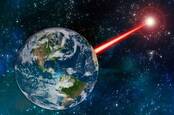This article is more than 1 year old
Zero. Zilch. Nada. That's how many signs of intelligent life astroboffins found in probe of TEN MILLION stars
Survey was huge, but we can do better - So don't go all '2020 sure is the year for feeling alone' on us, OK?
The latest survey searching for signs of alien civilizations radiating from over ten million distant Suns and six known exoplanets in space has thrown up a big fat nothing.
“We observed the sky around the constellation of Vela for 17 hours, looking more than 100 times broader and deeper than ever before,” said Chenoa Tremblay, a postdoctoral researcher at the CSIRO Astronomy and Space Science. “With this dataset, we found no technosignatures - no sign of intelligent life.”
“Technosignatures are the electric signals that are sent out through communication,” Tremblay explained to The Register. “This is can be those created by making a call on your cell phone or a radio station broadcasting out their listeners. These are examples of technosignatures that are purposefully created and sent around our planet. We could also purposefully send out signals purposefully out into space as well.”
Tremblay and Steven Tingay, an astronomy professor at Curtin University, focused the Murchison Widefield Array (MWA) telescope in the Southern sky in 2018. They hoped to detect the rumbles of anomalous low-frequency radio waves between 70 and 300 MHz being emitted from extraterrestrial forms of technology, so-called “technosignatures”, a sign of an advanced alien society.
But, alas, they found nothing out of the ordinary flickering in the heavens. Tingay was not disheartened, however, and said the lack of results didn’t necessarily indicate that intelligent species do not exist elsewhere. Instead, their search just wasn’t big enough. “As Douglas Adams noted in The Hitchhiker's Guide to the Galaxy: ‘Space is big, really big’.”
“And even though this was a really big study, the amount of space we looked at was the equivalent of trying to find something in the Earth’s oceans but only searching a volume of water equivalent to a large backyard swimming pool.”

With intelligent life in scant supply on Earth, boffins search for technosignatures of civilizations in the galaxy
READ MOREHe also suggested that scientists should hunt for technosignatures using methods other than just tuning in to cosmic radios. Similar efforts conducred by other academics have looked for odd infrared or gamma radiation. NASA recently awarded a research contract to astrophysicists from Harvard University and the University of Rochester to detect technosignatures that might be harvesting or producing light from solar panels.
“Although there is a long way to go in the search for extraterrestrial intelligence, telescopes such as the MWA will continue to push the limits—we have to keep looking,” Tingay said. He hopes that the Square Kilometre Array (SKA), a proposed system made up to a million radio dishes collectively covering an area of at least one square kilometer in Australia and South Africa, will be built and used to look for technosignatures across a wider range of space and depth.
“With the SKA, we’ll be able to survey billions of star systems, seeking technosignatures in an astronomical ocean of other worlds.” The SKA is expected to be the world’s largest radio telescope. To process all the data, astronomers will need two giant supercomputers capable of transmitting data at a “rate 100,000 times faster than the projected global average broadband speed in 2022,” according to the project's site.
The duo's results have been published in the Publications of the Astronomical Society of Australia (psst...here's the free arXiv pre-print.)®
